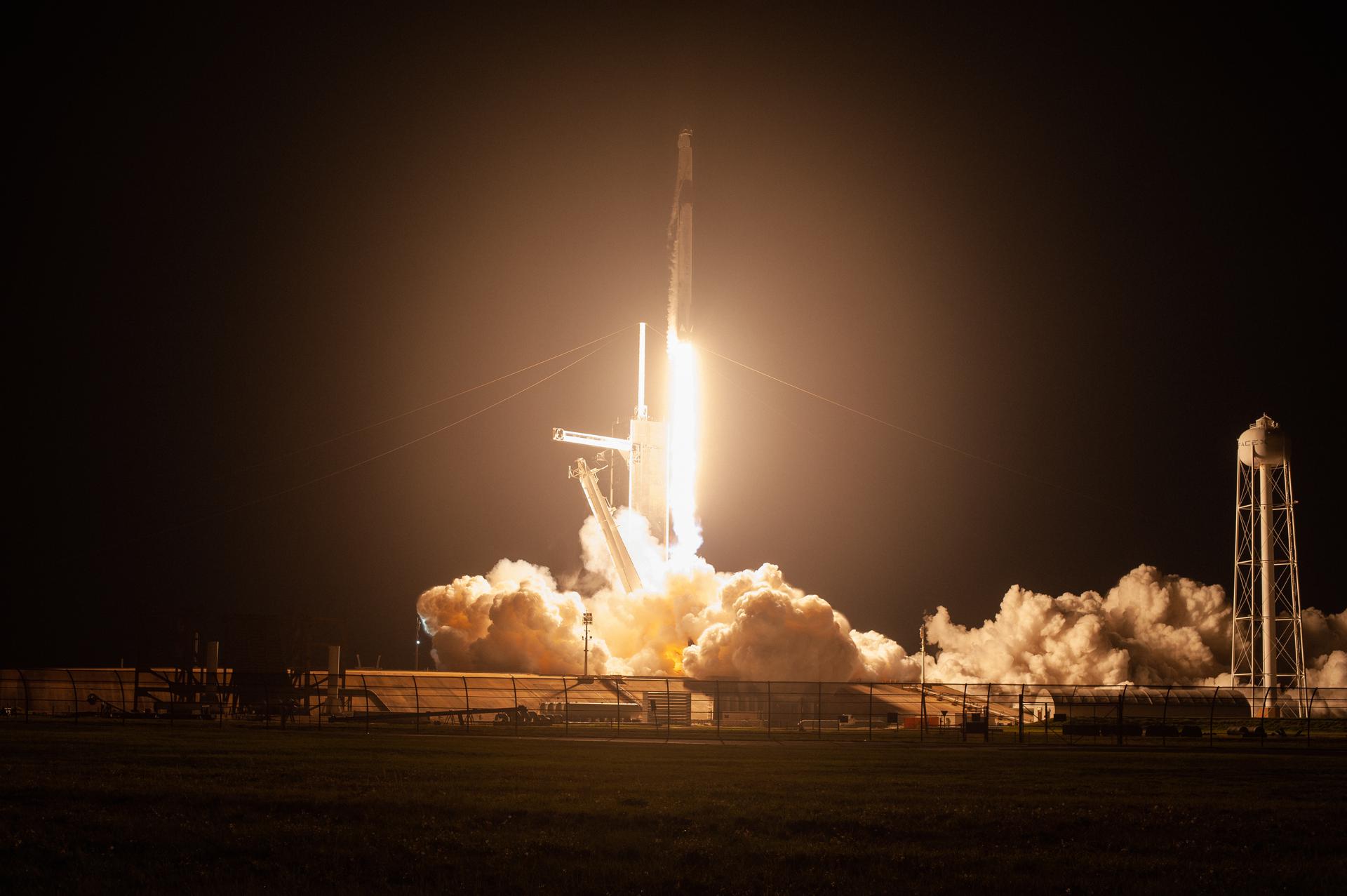Stay Up to Date
Submit your email address to receive the latest industry and Aerospace America news.
First stage launched crew to station last November
This story has been updated.
CAPE CANAVERAL, Florida — The SpaceX Falcon 9 rocket and Dragon crew capsule that lifted off from NASA’s Kennedy Space Center moments ago to deliver four astronauts to the International Space Station could also carry NASA and SpaceX a step closer to driving down launch and recovery costs by reusing spacecraft and components.
Some view the strategy as essential for opening up human travel to the moon, Mars and beyond. Reusability is the “holy grail” that will help “make life multiplanetary,” said Benji Reed, SpaceX’s senior director of human spaceflight programs, during a pre-launch briefing.
As Reed spoke, the Falcon 9 that lifted off today at 5:49 a.m. local time was awaiting launch, the exterior of its first stage streaked with soot from its November launch of four astronauts to the station in the Crew-1 mission. The liftoff of that stage today marks the first time NASA has launched astronauts on a rocket powered by a previously flown booster. The Crew-2 astronauts also are now on their way to the station in the same Dragon capsule, named Endeavour, that carried two NASA astronauts to the station last May for the Demo-2 mission that cleared the way for contracted flights with SpaceX.
NASA felt good but not cavalier about entrusting the lives of astronauts to the booster because of a 10-month-long certification process to clear the vehicle and the capsule for a single re-use under the agency’s Commercial Crew contract with SpaceX. The process included observing SpaceX workers on site as they readied the rocket and capsule flown today.
“It’s not that we don’t trust them. It’s just an additional safety measure,” said NASA’s Tom Simon, the certification manager for the SpaceX crew transportation system, in a pre-launch video interview from NASA’s Johnson Space Center in Houston.
SpaceX’s Bill Gerstenmaier said the company would not “get lulled into thinking this is fully operational and we’re ready to just continue this in an easy manner. This is still very much a learning experience for us.”
Adding to NASA’s confidence, SpaceX has landed and refurbished individual Falcon 9 stages multiple times to launch its Starlink broadband satellites, among other payloads. In fact, SpaceX is preparing to reuse an individual Falcon 9 booster for the 10th time on an upcoming Starlink launch.
“I think SpaceX has proven they’re pretty darn reliable with the number of launches they’ve had,” said Bob Cabana, director of Kennedy Space Center, in a pre-launch briefing.
At 5:59 a.m. local time, SpaceX’s John Insprucker confirmed that the booster from today’s launch had “successfully landed” on the Of Course I Still Love You droneship.
Yet another reusability milestone will come on April 28, when the Crew-1 Dragon capsule and its crew are scheduled to depart ISS for a splashdown in the Atlantic Ocean off Florida. The capsule contains a design improvement that NASA has entrusted for cargo missions but not yet astronauts. Here’s the back story: After the Demo-2 capsule splashed down in August, inspectors found heat damage associated with the gaps under the heat shield’s surface and the panels over the locations where the four landing legs in SpaceX’s original Crew Dragon design would have gone. Years ago, NASA expressed discomfort about the landing leg approach, at least for the time being, so SpaceX shifted to a landing at sea under parachutes and elected to cover the leg holes with panels and thermal protective materials rather than conduct a redesign.
When Demo-2 returned, “we saw a little damage, nothing critical,” said Justin Kerr, manager of the Commercial Crew program’s spacecraft office, which ensures that the Crew Dragon and in-development Boeing Starliner capsules meet the agency’s requirements. SpaceX decided to plug the gaps with a silicon material with iron embedded in it. “Think of it like caulking in your bathroom,” except the requirement here is avoid allowing hot gas in during entry, Kerr explained.
SpaceX plans to refurbish the Crew-1 capsule for the Inspiration-4 mission, scheduled to launch in September. The three-day orbital flight would mark the first time SpaceX has launched private citizens.
With three NASA crew launches completed, “this about the right time to start bringing some commercial folks in and some private astronauts in,” Gerstenmaier said.
Ben Iannotta reported from Cape Canaveral; Cat Hofacker reported from Washington, D.C.
About Ben Iannotta
As editor-in-chief from 2013 to March 2025, Ben kept the magazine and its news coverage on the cutting edge of journalism. He began working for the magazine in the 1990s as a freelance contributor. He was editor of C4ISR Journal and has written for Air & Space Smithsonian, New Scientist, Popular Mechanics, Reuters and Space News.
About cat hofacker
Cat helps guide our coverage and keeps production of the print magazine on schedule. She became associate editor in 2021 after two years as our staff reporter. Cat joined us in 2019 after covering the 2018 congressional midterm elections as an intern for USA Today.
Related Posts
Stay Up to Date
Submit your email address to receive the latest industry and Aerospace America news.






